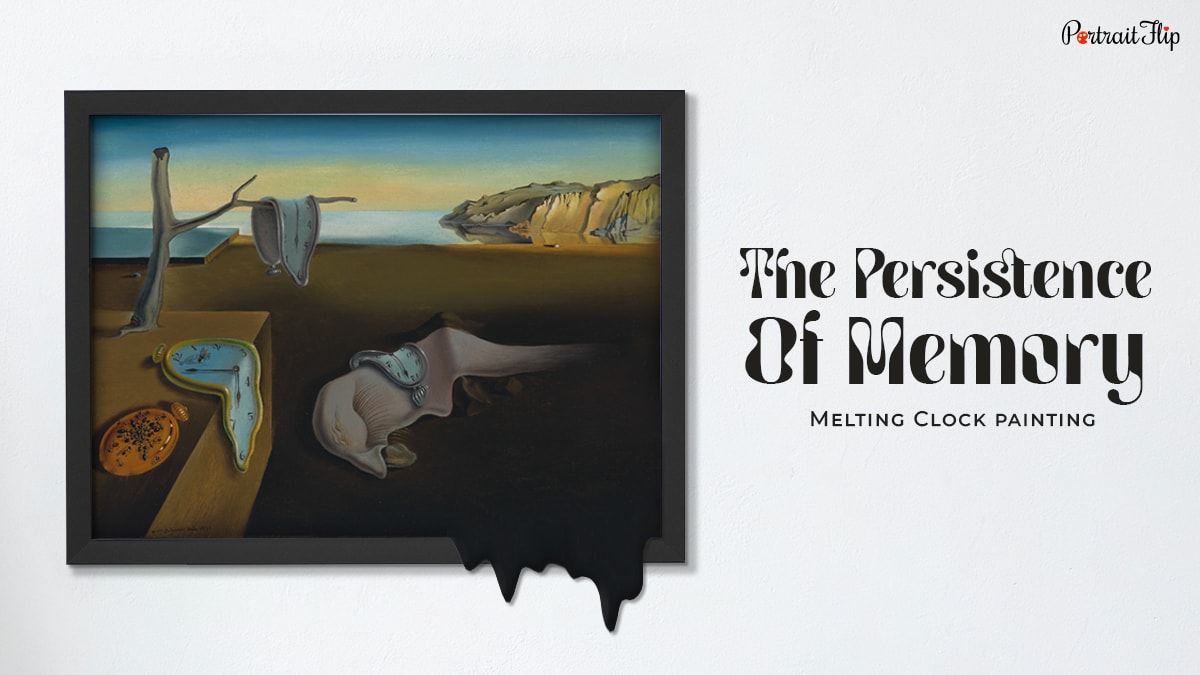The Museum of Modern Art is home to a painting that has been acing the show for a while now.
The painting that makes everybody wonder, “What the hell are we looking at?”
It’s none other than — The Persistence of Memory by Salvador Dali!
Also known as The Melting Clock Painting, this 1931 creation by Dali is more than just a surrealist artwork and has many vivid meanings behind it.
Aren’t you curious to know what this painting is all about?
We thought that it would be interesting to talk about the painting The Persistence of Memory and why it is so insanely popular.
Fasten your seat belts, because what you are going to read will stun you and give you a whole new perspective on surrealist art.
After all, it’s the great Dali’s masterpiece!
Table of contents
- Salvador Dali..a Surrealist Artist?
- Why did Salvador Dali Paint The Persistence of Memory?
- Overview on The Persistence of Memory
- Dali’s Paranoiac Critical Methods
- The Interpretation: What does the Persistence of Memory Mean?
- Is There Another Persistence of Memory by Dali?
- Secrets Behind the Melting Clock Painting
- Legacy and Location: Where is the Art Now?
- Hi from the Writer
- FAQs
Salvador Dali..a Surrealist Artist?
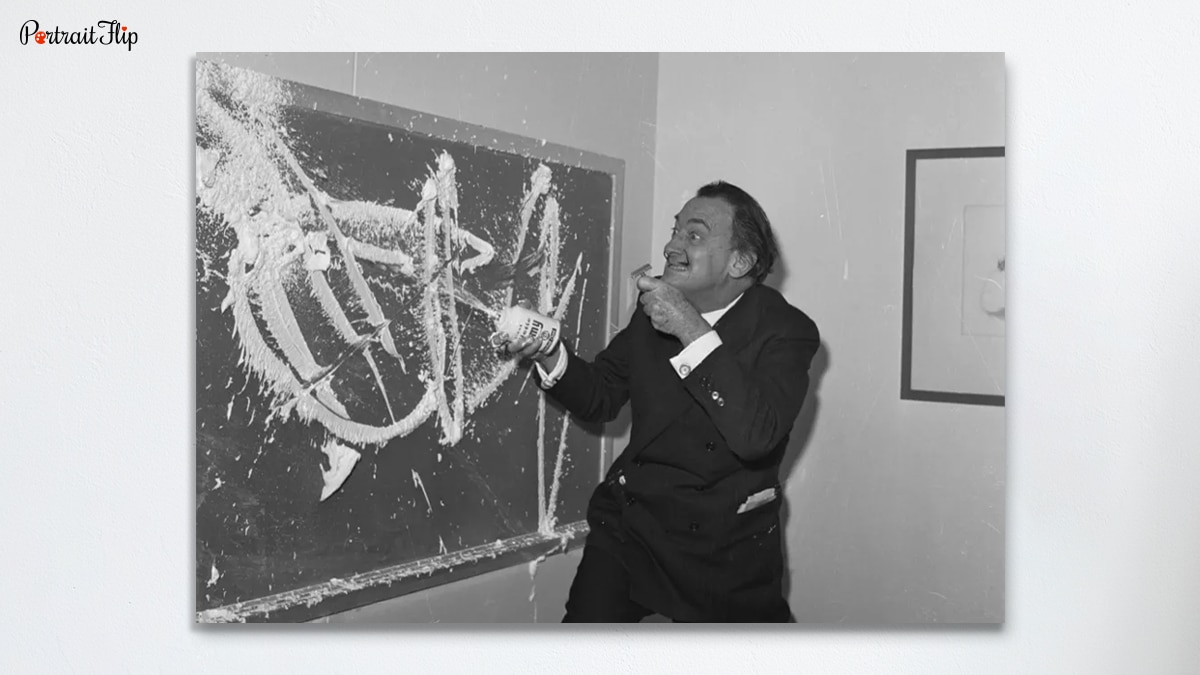
In 1904, Spain got an artist who was going to be renowned in many ways.
Dali made his way into the top five Spanish artists.
It wasn’t just Guernica by Picasso or Leonardo’s Mona Lisa that topped the list. Salvador Dali created this iconic painting which became the most famous in the history of art.
He was the first artist to put his hands on a theme that depicted dreamscapes.
During his trip to Paris, he joined the surrealist group that eventually gave birth to the masterpiece we are talking about today.
Dali was heavily influenced by the Surrealism movement.
This led him to experiment and put his hands on various forms of art.
Ultimately, the strangely melting watches were produced and gained popularity with their not-so-descriptive look.
But a question that makes us think is what made this small imagery of clocks and rocks by Dali different from the other surrealist artists?
What exactly do these melting clock paintings mean?
To answer this question, let’s take a small trip back to 1931, when this melting clock painting was created.
Suggested Read: Magritte’s The Son Of Man
Why did Salvador Dali Paint The Persistence of Memory?
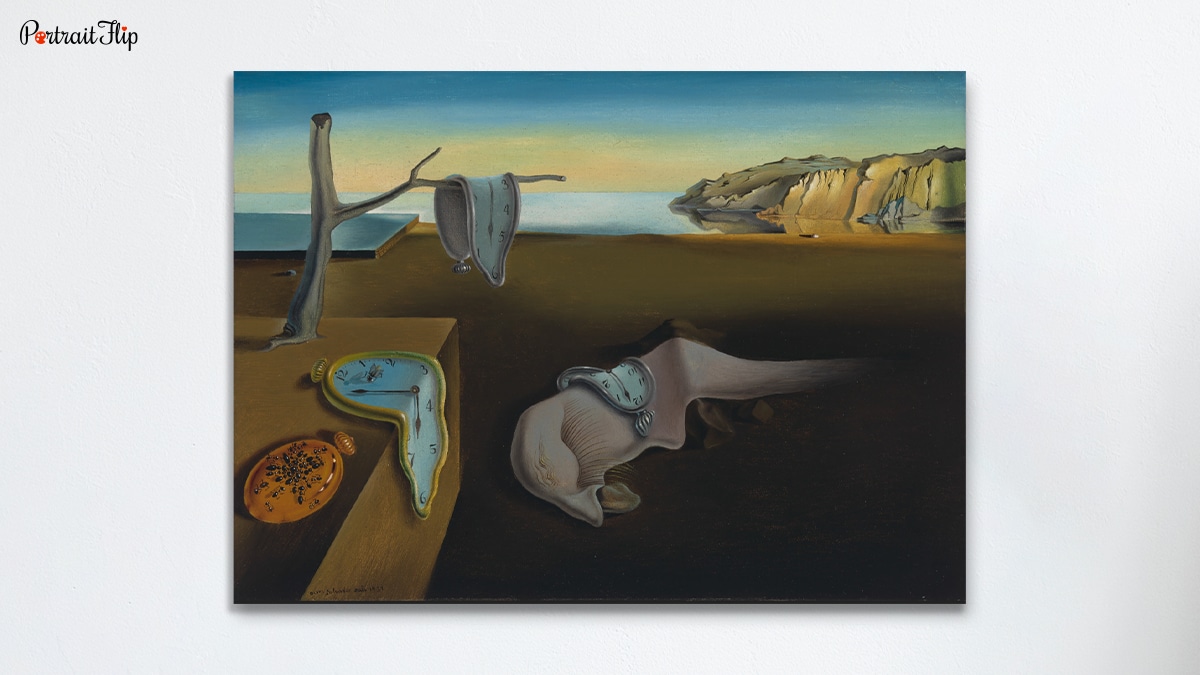
In 1931, Salvador attended the San Fernando Academy of Art in Madrid.
He was in his late 20s and living in a cottage with his future wife, Gala.
We already know that during his trip to Paris, he joined the surrealism group, which enhanced his thoughts about the paintings.
Dali, who visited Paris several times, began to experiment with surrealism in his works.
He hardly knew what he was getting himself into and that his decision was largely going to impact the art world.
The experiments he underwent while developing the final artwork were one of his great achievements that led to him becoming one of the most famous artists in the world.
He started planting seeds with the knowledge he gained from the movement, which eventually gave birth to the famous painting—The Persistence of Memory.
The consistency in creating something new and unique reflects Daliesque in the artwork.
Dali spoke to the audience about his hyper-realistic imagery that portrayed an impossible, dreamlike place.
He wanted to force his viewers to witness something that is indescribable and undefinable.
Salvador makes his viewers wonder, what is actually real? Even if it is just for a second.
To get more of Dali’s perspective, let’s get an overview of the painting The Persistence of Memory.
Overview on The Persistence of Memory
If you had your first glance at the painting The Persistence of Memory, what would you think? What thoughts will cross your mind?
A painting of still life? A place where time has stopped? Why are there melting clocks?
When you walk visually into the painting, you enter a deep, open, yet lonely space where everything is still and quiet.
A desert-escape where time has power or where time does not carry a lot of weight.
It could be both, depending on how Persistence of Memory Dali wants to portray it.
To get a crystal clear view of the painting, why not know about each object that adds life to this art?
Let’s discuss The Persistence of Memory analysis!
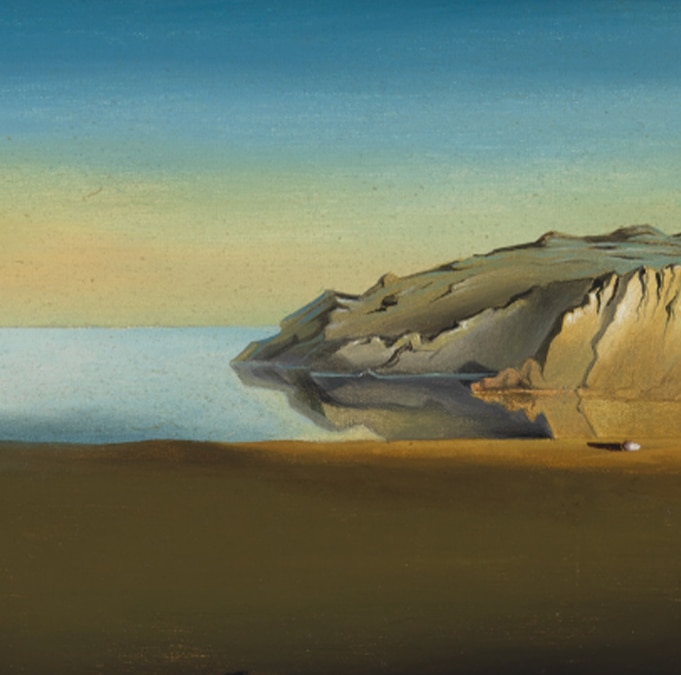
a) Landscape
Look at this landscape closely.
What do you feel? A quiet sea? Water without any movement?
Did you notice that the water is so still that the reflection of the landscape is clearly seen, as if there is another dimension in the sea?
A master move for sure!
Living near the Mediterranean Sea, which is clearly visible from Dali’s cottage, it’s no surprise that his paintings have a resemblance to landscapes and calm waters.
The scene and cliffs help connect the piece with Dali’s personal experience with the stay.
If you notice, there is a ray of light reflected on the cliff that gives a view of the sunset.
It makes the viewer feel like another day has passed with no change.
There is literally no activity or wave in the water, with a feeling of a deserted area with a hot climate around.
An absurd environment that is created with small details in the picture gives the art an authentic yet illogical appearance.
If we are talking about illogical looks, then Dali’s melting clock can’t be far behind. Let’s hear what the painting of clocks wants to say!
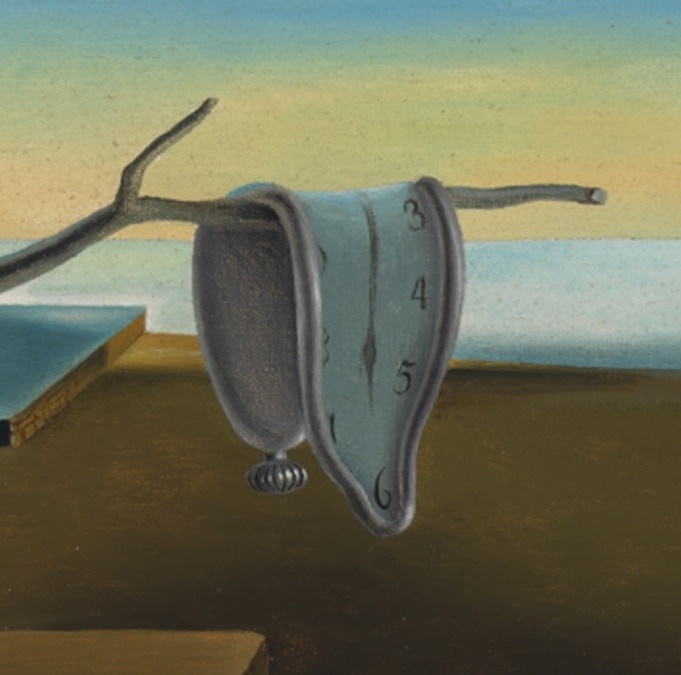
b) Melting Clocks
The meaning of Dali’s The Persistence of Memory revolves around the painting of melting clocks.
These melting watches are a significant part of the entire work.
What ideas do you get when you see these three melting clocks in a frame on different surfaces?
At first glance, the painting looks like it is in a liquid state, almost about to flow out of the canvas.
When asked about these melting watches, Dali replied that they were inspired by melting cheese, which, in an obvious manner, doesn’t sound like a fair answer.
The expectations between liquid and solid are far away.
Time is always viewed as a permanent and solid part of human life.
Humans respond to the ticking sounds of time and work accordingly.
The dropping clocks give out an interesting idea, as watches are always seen as a regimental tool.
But here Salvador Dali’s melting clock makes the viewers wonder, what exactly does it respond to?
He refers to the passing time that a person is experiencing in their sleep.
Time has always ruled the world, but in Dali’s world, things are slightly different.
Basically, it’s surreal!
There is no doubt that the concept of time in this dreamland is not moving the way it should.
In a place where time is unreliable and everything is illogical, how can someone guarantee other elements?
A beautiful surrealist touch by Salvador Dali is indescribable through these melting watches.
This isn’t the first time that Dali has depicted a melting clock in his artwork.
The Premature Ossification of a Railroad Station, created in 1930, also has a small portrayal of the watch concept.
Due to these amazing concepts introduced by Dali, he is known among famous surrealist artists!

c) Ants on Orange Metal
I wonder what this orange-metal depicts in the picture.
Does it resemble a watch, or is it another surrealist symbol by Dali?
He may have added this orange material for extra emphasis, but the ants are, of course, depicted for some reasons.
Have you ever seen a dead being?
If you have witnessed it, then you must know that the things that have ants all over them are a symbol of death.
If you look at the work closely, the ants are gathered in one place as if they are moving over decay.
They seem to be attracted to the orange piece of metal that is decomposing.
But what exactly is rotting that makes the ants gather at that particular set?
The time, which is in a decaying state in this dreamland by Salvador, was captured by congregating ants.
These little creatures on a solid structure like a watch give meaning to Dali’s The Persistence of Memory painting.
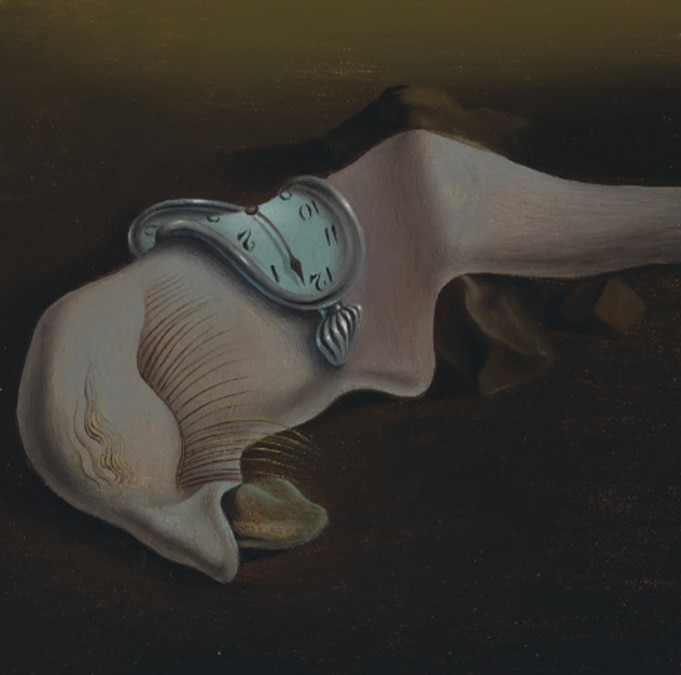
d) Other Surreal Figures
Now tell me, what thoughts crossed your mind as soon as you saw this structure in this melting clock painting?
Bizarre? Weird shape? Broken branch of a tree? A dead creature?
If you tilt your head slightly to the left, you’ll notice a big nose, big eyes, long eyelashes, and a thick tongue.
The features that are seen in normal humans could be visible in this giant creature.
If you have noticed different artworks by Salvador Dali, you’ll find that the portrayal of this figure is very common in his paintings.
Because of the way he portrays this shape, many admirers believe that it is none other than Dali himself.
The self imagery of the artist depicted in the melting clock painting makes the audience think about what the persistence of memory means through Dali’s eye.
Dali often called his art hand-painted dream photographs, which is clearly seen in this melting clock painting through the bizarre figure with his eyes closed as if he is in a dreamland.
In the image below, we can see the same strange and peculiar shape in the paintings produced by Dali.
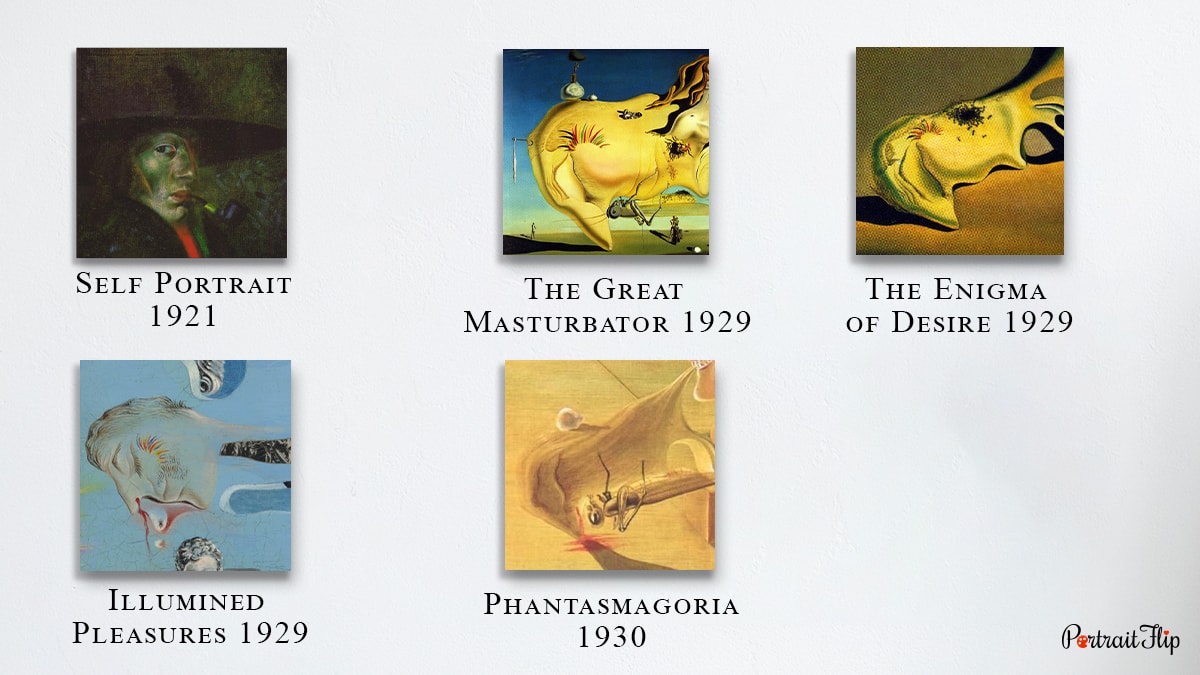
Dali’s Paranoiac Critical Methods
What does this topic name suggest? Dali’s paranoiac critical methods?
Let me tell you that Dali always tends to develop his own techniques and give them his name.
This method was defined as a hallucination state where Salvador enters and creates “hand-painted dream photographs.”
It gives meaning to Dali’s mindset before he started to paint.
As a surrealist and cubist artist, he introduced a technique where he would self-induce a hypnotic state, which allowed him to break into a space where reality bends.
He creates a dimension that is different from what it reflects in actual life.
A delusional state where he tries to paint a picture that makes the viewer stunned and question what the real truth is.
Do you know what genre Dali’s The Persistence of Memory is?
The answer is: allegory!
He typically colored the melting clock painting on canvas or wood panels.
To emphasize his important figures, he would add a highly detailed picture over the landscape with a black or blue pencil.
After that, he would add the oil paints over those figures to give hyper-realistic results.
As an artist, he was confident in what exactly he wanted to portray to the world.
Dali was highly inspired by Sigmund Freud and the way he put his subconscious mind on paper.
He maintains a delusional, dreamlike structure in his paintings, which he later named according to his mental state—paranoiac critical.
The Interpretation: What does the Persistence of Memory Mean?
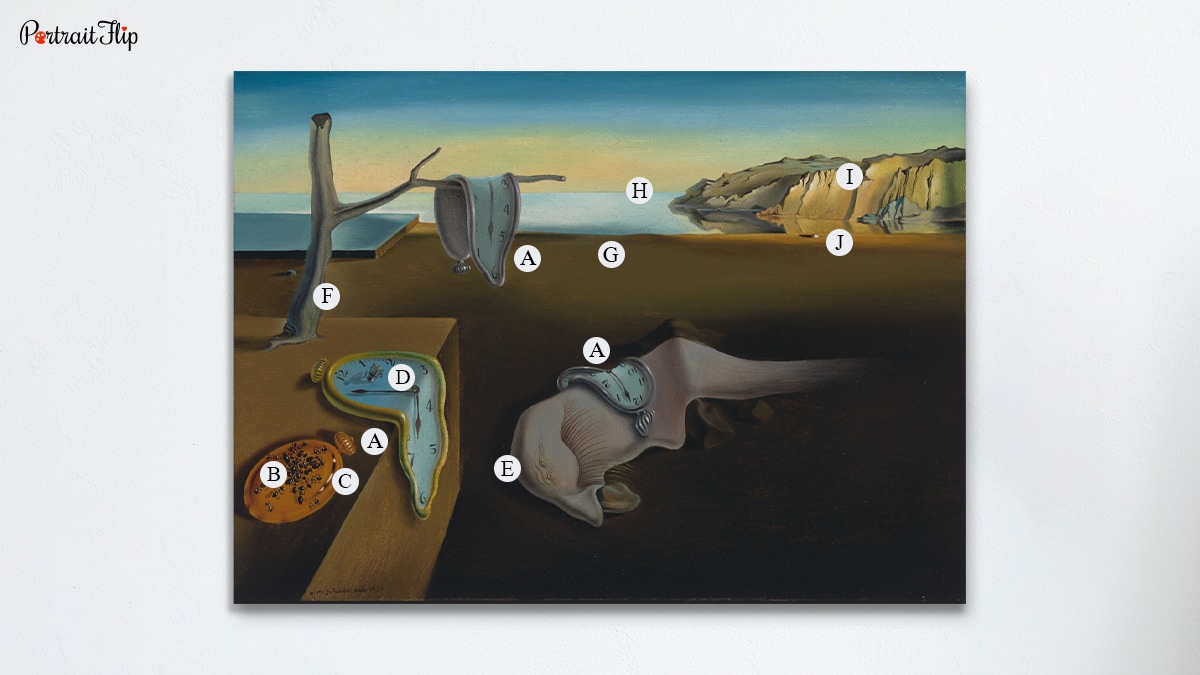
We have been talking about The Persistence of Memory by Salvador Dali for a while, but what exactly does it mean?
What is persistence in the picture? What kind of memory is melting clock artist talking about?
Salvador Dali’s clock painting plunges the audience into a dimension where reality bends.
He makes people enter a dreamlike, strange universe where the concept of timing (solidity) doesn’t exist.
One thing that Dali’s art brings clarity to is that the time is clicking but the memory persists with the person.
To get a viewpoint on what this melting clock painting means, we have discussed each object that enhances the Salvador Dali painting.
The Symbolic Representation
a) The three melting clocks symbolize the time that is passing by in our dreams. Each watch is placed on different levels, representing temporality.
b) As discussed earlier, the ant represents death and decay. During the artist’s childhood, he observed the ants feeding on the decomposed body of a bat, which he later implemented in his artwork as a symbolic representation.
c) The orange metal in a clock shape symbolizes a stiff time that is covered by ants, which means that the time is dead in this dreamland.
d) The insect on the melting clock signifies the phrase “time flies.”
e) The strange figure represents Dali himself, who is captivated by a dream world and nature.
f) The dead olive tree that is known for wisdom signifies the past, which is dry and dead.
g) The vacant beach represents the emptiness in the artist’s life.
h) As we talked about the stillness in water, that represents a memory, as if they have given time to settle down.
i) The cliff represents the painter’s memory, which is in his subconscious mind.
j) Did you notice a small egg near the shoreline? Yes, that little thing is a symbol of birth or re-establishment.
If you observe the art, you’ll find an unbearable quietness that brings a feeling of restlessness. These small details make Salvador Dali’s Persistence of Memory a masterpiece.
There is a silent question at the end of this sentence, which asks whether there is another melting clock painting as well.
Is There Another Persistence of Memory by Dali?
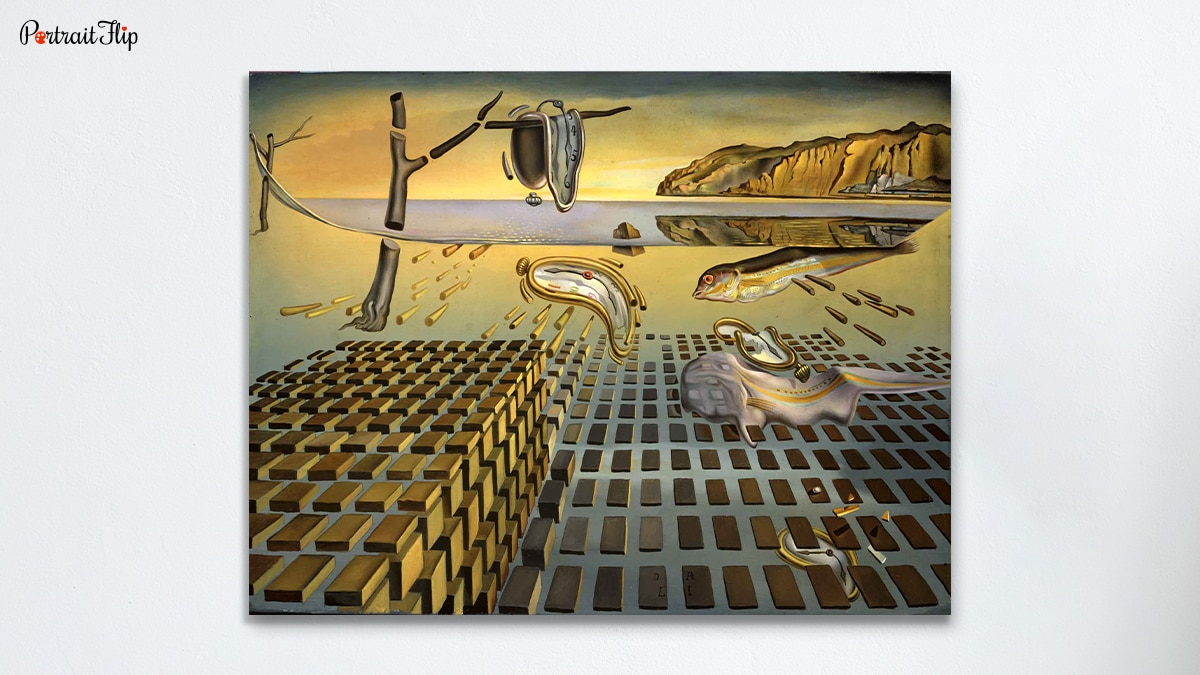
Yes, there is another melting clock painting by Salvador Dali.
After the creation of The Persistence of Memory, he brought another version that has almost the same concept and title, known as “The Disintegration of The Persistence of Memory.”
Do you know what disintegration means? Well, it is a process of losing strength and coming to pieces.
This meaning gives a crystal clear picture of the version, as we observe that the object is breaking into pieces while flooded with water all over.
It depicts what is occurring above as well as below the surface.
He shows the underside of the painting that has blocks (referring to nuclear weapons) and the way everything is floating.
But what makes Salvador Dali paint “The Disintegration of The Persistence of Memory?”
If I told you that this painting is a creation of Dali’s disinterest in surrealism, what would be your reaction?
Yes, it’s true! An artist known for his surrealism has a new interest in his books, which is known as science.
Dali’s interest was taking a turn into scientific terms, and he wished to break them down in his new creations.
As a result, in 1954, “The Disintegration of The Persistence of Memory” was created, in which he shows a deconstruction of his previous work.
What a genius, I must say!
If you are into surrealist artwork, then here’s a collection of paintings by Picasso, who is another great example of a surrealist artist!
Secrets Behind the Melting Clock Painting
Of course this section has to be included in the blog because, let’s face it, a painting that is insanely famous surely hides some secrets within itself.
Let’s hear about the painting we know but the secrets we don’t!
- Despite being the most impactful artwork in the world, this melting clock painting is just slightly larger than a notebook paper, with a measurement of 9.5 by 13 inches.
- Apart from reflecting Freud’s analysis in his paintings, Dali’s emphasis on the melting watches refers to Einstein’s Theory of Relativity.
- An anonymous patron donated this Salvador Dali artwork to the Metropolitan Museum of Art.
- It is believed that the three melting clocks represent the past, present, and future. Although it is subjective and open to various interpretations.
- This melting clock painting is said to be the combination of three art genres: landscape painting, still life artwork, and a self-portrait.
- Dali was only 27 years old when he painted The Persistence of Memory.
- The painting may get counted among one of Dali’s self-portraits due to the strange figure portrayed in the artwork, which is believed to be the face of the artist.
- If you google words like melting clock painting, soft watches, droopy watches, or the persistence of time, you’ll find that they all refer to the same artwork, which means that it has many aliases.
I have talked about eight major facts about the painting. There could be many more hidden facts added to the artwork, which is still invisible to our naked eyes!
Legacy and Location: Where is the Art Now?
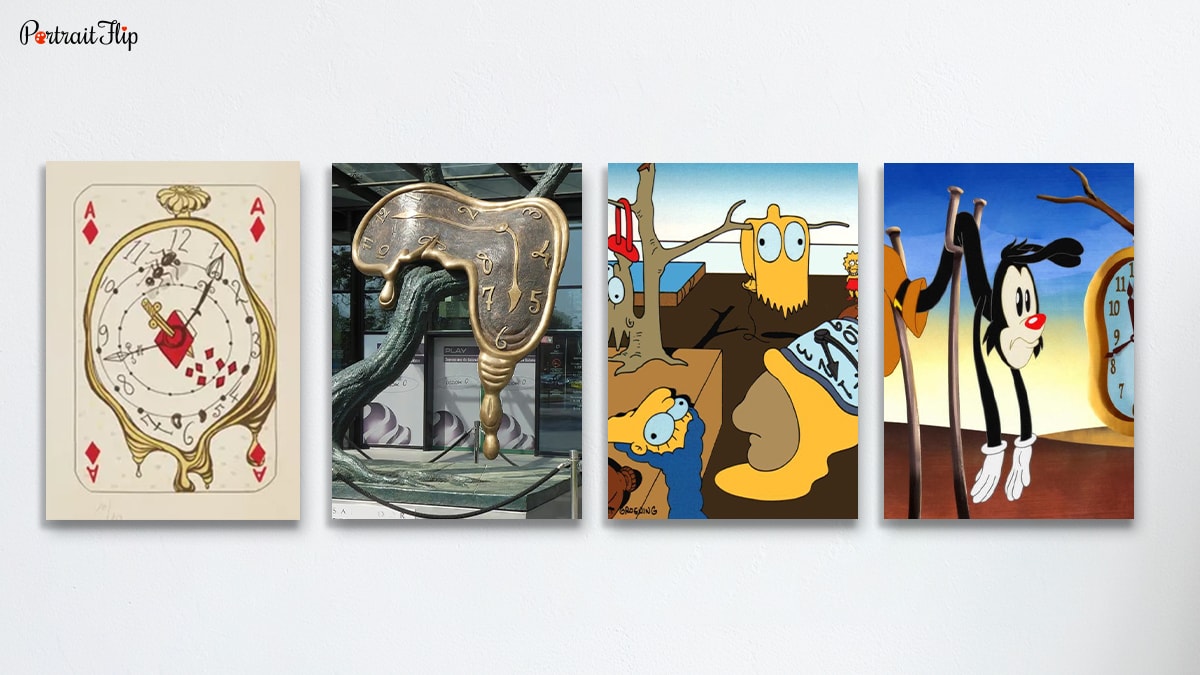
For 89 years and counting, the painting has been in the collection of The Museum of Modern Art.
If we talk about the legacy that this melting clock painting carries, then this section will be flooded with various examples.
To be precise, many famous painters incorporate this melting clock concept into their artwork.
They were inspired by the methods introduced by Dali and a vivid description of people’s subconscious minds.
The above image gives a clear view of how the painting has influenced the world on a larger scale.
Even Salvador Dali released a 17-card surrealist concept that has a depiction of melting clocks in it.
Pop culture has introduced painting in different styles that reflect their perspective on it.
Famous shows such as The Simpsons, Hey Arnold, Doctor Who, and Looney Tunes have interesting ways to portray Dali paintings.
The film “The Persistence of Memory” was made by director Candace Amiguet in 2014.
If we speak about how much Dali’s The Persistence of Memory is worth, then that would be another topic.
The most expensive painting by Dali was Portrait de Paul Eluard, which was sold for nearly $14.7 Million in 2011.
This price gave a baseline for the melting clock painting’s worth, which was sold for $150 Million in 1934.
Marvellous!
Lastly,
An artwork created by a Spanish painter—do you know what the Spanish translation of the melting clock painting is?
It is known as “La persistencia de la memoria.” Beautiful, isn’t it?
Well, how about you bring this beautiful artwork, which is full of mysteries and interpretations, home?
Get your own melting clock painting that will add meaning to your wall with its surrealism.
Hi from the Writer
How did you find the blog, “The Persistence of Memory: Dali’s Melting Clock Painting?”
Interesting, knowledgeable, full of contents and facts? You must have various questions to ask and some suggestions to give, right?
Enlighten me with your personal insight about the painting through comments, or you can even write to me at- [email protected].
A story about a surrealist painting seen through different eyes will be amazing to hear!
You can also follow us on social media pages like Instagram or subscribe to our YouTube channel, where we regularly update new content.
Till then, keep reading. See you soon in the next blog!
FAQs
Salvador Dali is the artist behind this surreal artwork.
When asked by Dali about what he thinks about his own artwork, his reply was, “The usual paralyzing tricks of eye-fooling.”
Despite being the most famous work in the history of art, the melting clock painting is no larger than a notebook. The dimensions of the artwork are 9.5 by 13 inches.
The melting clock painting was painted in 1931.
Dali gives his viewpoint on time, which is passing by but leaving behind memories.
The colors used in this painting are orange, yellow, brown, black, grey, and white.

